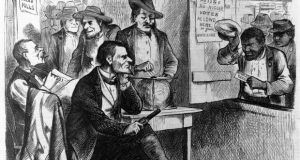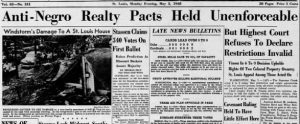Voter Restriction Laws

After the Great Compromise in 1877 states across the country, the focused more in the South established voter restriction laws which subverted the 15thamendment as it did not overtly violate this statute, in that it did not outright bar African Americans from voting. Instead, it made voting for minorities extremely difficult. They did this in a multitude of ways ranging from poll taxes which required the voter to pay a fine, so they could vote, literacy tests which required the individual to answer questions about the constitution and read some of its sections, and finally the grandfather clause which made it so that only individuals whose grandfather could vote were allowed to vote. Mississippi was the first of the states to enact these voter restriction laws and revise their state constitution immediately following Reconstruction. Illustrating the legal manner by which states restricted the rights and daily life of African Americans.
Plessy v. Ferguson

This primary source was found in a catalogue of cases under the Supreme Court, in particular, the Fuller Court of 1896. The Plessy v. Ferguson decision which was decided on May 18, 1896, was a challenge to the Louisiana Separate Car Act of 1892. The conflict of this case was the separation of blacks and whites into separate rail cars. The Comite des Citoyens argued this act violated the 13thand 14thamendment. By the conclusion of the case with a 7-1 majority for Ferguson, the court decided that segregation or separation did not violate the 13thor 14thamendment. Primarily Justice Brown indicating the 14thamendment intends absolute equality, but segregation does imply the inferiority of African Americans. This decision addresses all Americans and sets the precedence for segregation in many facilities ranging from bus stations to movie theatres. While the law called for separate but equal spaces oftentimes this was not the case only propagating the values of White Supremacy over the decades and well into the twentieth century.
Shelly v. Kraemer (1948)

A Vinson Court ruling found in the library of Congress relates to the Shelley v. Kraemer case which was decided on May 3rd, 1948. This Supreme Court case was brought to fruition because of actions such as the 1911 St. Louis covenant to prevent races such as African Americans from living in the area. This was tested when the Shelley’s an African American couple wanted to move into one such town. In this instance, another individual by the name of Kraemer brought suit to enforce the towns covenant. The states supreme court enforced the towns covenant because it was private. However, the federal Supreme Court got involved when it became a question of the equal protection clause in the 14thamendment. Yet, it was a unanimous decision for Shelley. The majority opinion was given by Fred M. Vinson stating that racially based covenants do violate the 14thamendment however private covenants are legal but can’t be enforced by the law. This case affected the state’s ability to enforce such laws and the individual’s ability to use the law as a basis to enforce discriminatory practices. This fits with the theme as it helped dismantle discriminatory laws and laid the groundwork for decisions such as Jones v. Alfred H. Mayer Company.
